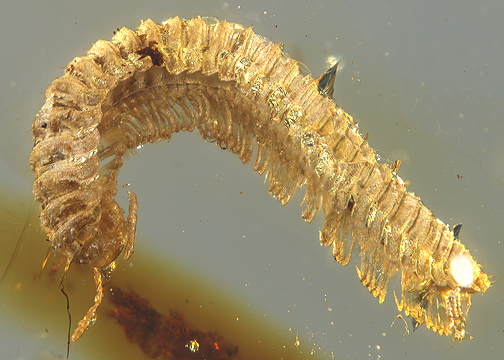Abstract
A new species of millipede from the family Heterochordeumatidae, Heterochordeuma liae sp. nov., is described from mid-Cretaceous Burmese (Kachin) amber. The detailed morphological characteristics of this species are provided based on the examination of 14 specimens, primarily utilizing confocal laser scanning microscopy. This new species can be confidently assigned to the extant genus Heterochordeuma due to its extended and polydesmidan-like paranota, 32 body rings in male and distinctive curved anterior gonopods, modified coxites 9, and leg-pair 10. A comprehensive comparison with extant species is also presented.
References
- Azar, D., Perrichot, V., Néraudeau, D. & Nel, A. (2003) New psychodid flies from the Cretaceous ambers of Lebanon and France, with a discussion about Eophlebotomus connectens Cockerell, 1920 (Diptera, Psychodidae). Annals of the Entomological Society of America, 96, 117–127. https://doi.org/10.1603/0013-8746(2003)096[0117:NPFTCA]2.0.CO;2
- Cai, C.Y. & Huang, D.Y. (2014) The oldest micropepline beetle from Cretaceous Burmese amber and its phylogenetic implications (Coleoptera: Staphylinidae). Naturwissenschaften, 101, 813–817. https://doi.org/10.1007/s00114-014-1221-z
- Cruickshank, R.D. & Ko, K. (2003) Geology of an amber locality in the Hukawng Valley, northern Myanmar. Journal of Asian Earth Sciences, 21, 441–455. https://doi.org/10.1016/S1367-9120(02)00044-5
- Enghoff, H., Golovatch, S.I., Short, M., Stoev, O. & Wesener, T. (2015) Diplopoda – taxonomic overview. In: Minelli, A. (Ed.), Treatise on Zoology – Anatomy, taxonomy, biology. The Myriapoda. Volume 2. Brill, Leiden and Boston, pp. 363–453. https://doi.org/10.1163/9789004188273_017
- Fu, Y.Z., Li, Y.D., Su, Y.T., Cai, C.Y. & Huang, D.Y. (2021) Application of confocal laser scanning microscopy to the study of amber bioinclusions. Palaeoentomology, 4, 266–278. https://doi.org/10.11646/palaeoentomology.4.3.14
- Grimaldi, D.A., Engel, M.S. & Nascimbene, P.C. (2002) Fossiliferous Cretaceous amber from Myanmar (Burma): its rediscovery, biotic diversity, and paleontological significance. American Museum Novitates, 3361, 1–71. https://doi.org/10.1206/0003-0082(2002)361<0001:FCAFMB>2.0.CO;2
- Hoffman, R.L. (1963) Notes on the structure and classification of the diplopod family Heterochordeumatidae. Annals and Magazine of Natural History, ser. 13, 6, 129–135.
- https://doi.org/10.1080/00222936308651333
- Jiang, X.K., Shear, W.A., Hennen, D.A., Chen, H.M. & Xie, Z.C. (2019) One hundred million years of stasis: Siphonophora hui sp. nov. the first Mesozoic sucking millipede (Diplopoda: Siphonophorida) from mid-Cretaceous Burmese amber. Cretaceous Research, 97, 34–39. https://doi.org/10.1016/j.cretres.2019.01.011
- Li, Y.D., Ślipiński, A., Huang, D.Y. & Cai, C.Y. (2023) New fossils of Sphaeriusidae from mid-Cretaceous Burmese amber revealed by confocal microscopy (Coleoptera: Myxophaga). Frontiers in Earth Science, 10, 901573. https://doi.org/10.3389/feart.2022.901573
- Liu, W., Rřhr, P.T. & Wesener, T. (2017) A look with μCT technology into a treasure trove of fossils: The first two fossils of the millipede order Siphoniulida discovered in Cretaceous Burmese amber (Myriapoda, Diplopoda). Cretaceous research, 74, 100–108. https://doi.org/10.1016/j.cretres.2017.01.009
- Mao, Y.Y., Liang, K., Su, Y.T., Li, J.G., Rao, X., Zhang, H., Xia, F.Y., Fu, Y.Z., Cai, C.Y. & Huang, D.Y. (2018) Various amberground marine animals on Burmese amber with discussions on its age. Palaeoentomology, 1 (1), 91–103. https://doi.org/10.11646/palaeoentomology.1.1.11
- Moritz, L. & Wesener, T. (2019) The first known fossils of the Platydesmida—an extant American genus in Cretaceous amber from Myanmar (Diplopoda: Platydesmida: Andrognathidae). Organisms Diversity & Evolution, 19, 423–433. https://doi.org/10.1007/s13127-019-00408-0
- Moritz, L. & Wesener, T. (2021) Electrocambalidae fam. nov., a new family of Cambalidea from Cretaceous Burmese amber (Diplopoda, Spirostreptida). European Journal of Taxonomy, 755, 22–46. https://doi.org/10.5852/ejt.2021.755.1397
- Ross, A.J. (2019) Burmese (Myanmar) amber checklist and bibliography 2018. Palaeoentomology, 2 (1), 22–84. https://doi.org/10.11646/palaeoentomology.2.1.5
- Ross, A.J. (2021) Supplement to the Burmese (Myanmar) amber checklist and bibliography, 2020. Palaeoentomology, 4 (1), 57–76. https://doi.org/ 10.11646/palaeoentomology.4.1.11
- Ross, A.J. (2023) Supplement to the Burmese (Myanmar) amber checklist and bibliography, 2022. Palaeoentomology, 6 (1), 22–40. https://doi.org/10.11646/palaeoentomology.6.1.6
- Ross, A.J., Mellish, C., York, P. & Crighton, B. (2010) Burmese amber. In: Penney, D. (Ed.), Biodiversity of fossils in amber from the major world deposits. Siri Scientific Press, Manchester, pp. 208–235.
- Shear, W.A. (2000) On the milliped family Heterochordeumatidae, with comments on the higher classification of the order Chordeumatida (Diplopoda). Invertebrate Systematics, 14 (3), 363–376. https://doi.org/10.1071/it99016
- Shear, W.A. (2012) Pyrgeuma pyrgodesmoides, n. gen. n. sp. a new millipede from Malaysia with unusual surface structures (Diplopoda, Chordeumatida, Heterochordeumatidae). Zootaxa, 9 (3560), 79–86. https://doi.org/10.11646/zootaxa.3560.1.5
- Shi, G.H., Grimaldi, D.A., Harlow, G.E., Wang, J., Wang, J., Yang, M.C., Lei, W.Y., Li, Q.L. & Li, X.H. (2012) Age constraint on Burmese amber based on U-Pb dating of zircons. Cretaceous Research, 37, 155–163. https://doi.org/10.1016/j.cretres.2012.03.014
- Stoev, P., Moritz, L. & Wesener, T. (2019) Dwarfs under dinosaur legs: a new millipede of the order Callipodida (Diplopoda) from Cretaceous amber of Burma. ZooKeys, 841, 79–96. https://doi.org/10.3897/zookeys.841.34991
- Su, Y.T., Cai, C.Y. & Huang, D.Y. (2021) Morphological revision of Siphonophora hui (Myriapoda: Diplopoda: Siphonophoridae) from the mid-Cretaceous Burmese amber. Palaeoentomology, 4 (3), 279–288. https://doi.org/10.11646/palaeoentomology.4.3.15
- Su, Y.T., Cai, C.Y. & Huang, D.Y. (2022) A new species of Trichopolydesmidae (Myriapoda, Diplopoda, Polydesmida) from the mid-Cretaceous Burmese amber. Palaeoentomology, 5 (6), 606–622. https://doi.org/10.11646/palaeoentomology.5.6.10
- Su, Y.T., Cai, C.Y. & Huang, D.Y. (2023) A new species of Polydesmidae (Myriapoda, Diplopoda, Polydesmida) from the mid-Cretaceous Burmese amber. Zootaxa, 5396 (1), 112–123. https://doi.org/10.11646/zootaxa.5396.1.16
- Su, Y.T., Cai, C.Y. & Huang, D.Y. (2024) Two new species of Siphonorhinidae (Myriapoda: Diplopoda: Siphonophorida) from mid-Cretaceous Burmese amber. Mesozoic, 1 (1), 70–89. https://doi.org/10.11646/mesozoic.1.1.6
- Silvestri, F. (1895) I chilopodi ed I diplopodi de Sumatria e della isole Nias, Engano e Mentavei. Annale Museo Civica Storia Naturale de Genova, 34, 707–760
- Wesener, T. & Moritz, L. (2018) Checklist of the Myriapoda in Cretaceous Burmese amber and a correction of the Myriapoda identified by Zhang (2017). Check List, 14 (6), 1131–1140. https://doi.org/10.15560/14.6.1131
- Yin, Z.W., Cai, C.Y. & Huang, D.Y. (2018) Last major gap in scydmaenine evolution filled (Coleoptera: Staphylinidae). Cretaceous Research, 84, 62–68. https://doi.org/10.1016/j.cretres.2017.10.026
- Zherikhin, V.V. & Ross, A.J. (2000) A review of the history, geology and age of Burmese amber (Burmite). Bulletin of the Natural History Museum, London (Geology), 56, 3–10.


